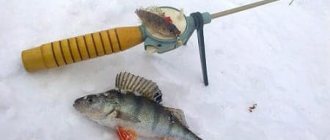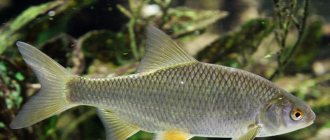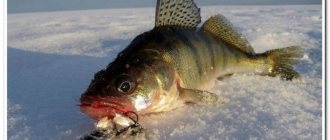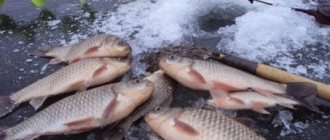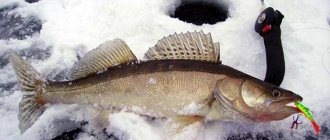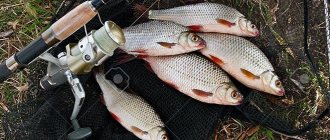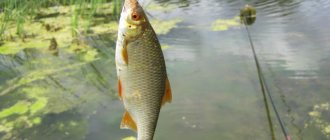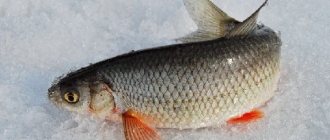Roach bite on the first ice
Catching roach in the first ice will be effective at stable atmospheric pressure, when there are no sudden changes. It is good to plan fishing when the pressure readings slowly decrease from high to low, from 742 to 737. Weather conditions have the most direct impact on underwater inhabitants.
The fish become more active on cloudy days when there are no strong gusts of wind. It bites better in light wet snow and thaw. You shouldn’t expect bites in frosty weather or when the atmospheric pressure “jumps”; the roach is passive on such days.
There are no specific hours here based on the time of day; the fish in this regard is unpredictable on the first ice. It is optimal to go hunting around noon and fish until 4 pm.
Where to look for roach on the first ice
You need to look for roach on the first ice in different bodies of water in different ways. In small water areas, small individuals, huddled in schools, often stay close to algae and coastal vegetation. You can find it in areas with shallow depth. But large specimens, in the form of scattered schools, prefer to be in depressions at the bottom of the reservoir.
At first, when frost has just set in, you should search for roach in shallow bays. When temperatures are consistently low and ice thickness increases noticeably, deeper water areas appear promising. Having discovered a school of fish, it is worth marking this area by throwing in a bait mixture.
For roach fishing on first ice to be successful, it is recommended to be more active in your movements. If there are no bites in the hole for 5-6 minutes, then you should not waste time waiting for a miracle and move on to the next one.
Most often, areas of a reservoir with a smooth transition of depths turn out to be successful. At the same time, it is better to cast the tackle in the middle of the bottom slope. You should not explore shallow water areas and very deep places; roach stays on the first ice at a depth of 2–3 m.
If you plan to hunt large individuals, then you need to look for them in secluded places; they try to avoid areas of the reservoir that are too illuminated. It is promising to fish on the river under high steep banks that block the water surface from the rays of the sun. In the absence of heavy snowfalls at the beginning of winter, the ice becomes transparent, which requires anglers who are actively looking for roach to be extremely careful and camouflaged. Any fuss or noise can easily provoke the fish to leave the feeding area.
Winter habitats
How to find roach on a pond in winter? In the cold season, this fish moves to deep areas, away from the shore. The optimal fishing depth is up to 5-6 meters. This fish doesn't stand any deeper. The parking location also depends on the amount of oxygen - the flock will not enter musty shallow muddy backwaters. Catching roach in winter will be successful in large areas with a slightly silted or hard bottom with numerous irregularities and changes at depths of 4-5 meters, on long exits from pits. The fish avoids strong currents, but likes to stand next to it in calm water. The main thing is that there is food, so there will be no track on bare sand either.
The largest fish of this species, weighing up to a kilogram, lives in deep holes with underwater vegetation and colonies of dreisna shells, often next to schools of bream. A mature sorog feeds on these shells, crushing the shells with its pharyngeal teeth. The number of such trophies is small, and it is advisable to hunt for them if the specific habitat is known. Therefore, the main fishing object is a medium-sized fish, weighing 200-400 grams. In winter, it gathers in large schools, and if you find an approximate square of its habitat, you can fish here all winter. In such places, fishing towns of tents are formed. True, due to the rotting of bait residues (or other factors), the fish can leave at any moment. Therefore, some fishermen prefer to search on their own, rightly hoping for larger specimens.
On small rivers
Finding roach in winter on small rivers is easier than on large reservoirs, due to the simple determination of the approximate bottom topography. And there are simply no vast areas for migration here. Holes are drilled in deep-water areas with vegetation, exits from pits, in places with reverse flow, and in sinkholes under a steep bank. Small rivers are promising places for catching roach in winter. Local fishermen, who thoroughly know their home rivers, catch roach in such treasured places all winter.
Reelless fishing
Catching sorog on the first ice using a reeler is quite effective; you can catch large specimens. But the tactics used must be well chosen, then you can count on the activity of the fish. When playing with a jig, the fisherman has no restrictions; everything depends on a creative approach. For greater efficiency, also use a live bait, then the process will become even more fun.
We recommend reading
Catching roach in winter with a reelless bait and the top best models Using a reelless reel for roach in winter is explained by excitement and high performance. By nature this...
What working jigs
When choosing a jig for large roach on the first ice in November, as well as for medium and small specimens, you need to focus on specific fishing conditions. If hunting is planned in a reservoir with calm water at shallow depths, then miniature options are suitable. If the fish is caught at a depth of 4–5 m, then medium-sized bait is used. Heavy models are more relevant for fishing at depth.
The hook number for roach is 13–18, the main thing here is to monitor the sharpness of the sting and, if necessary, sharpen it. The shape of the bait should be similar to aquatic microorganisms. Light-colored jigs for roach in winter work in areas with great depth, in cloudy weather. The dull colored versions are optimal when fishing in shallow waters in clear weather.
Among the catchable baits for roach on first ice are:
- gray/black ant;
- gray (red, black) droplet;
- black and white/black and gray Uralka;
- a gray devil with a raised body;
- barrel-shaped options;
- flat versions;
- pellets, etc.
Game without a rewind
In each new hole, playing with a jig begins with gliding movements, as if food were falling into the water. A pause is made every 30–50 seconds. It is this that allows you to attract the attention of the fish and find out the horizon of its location. There are times when roaches bite in the water column. There are situations when the catch is observed when fishing from top to bottom. Often the fish in a hurry takes the bait in its mouth, afraid of losing sight of it.
If, during stepwise or gliding retrieval, it was not possible to interest the fishing object, then it is worth experimenting at the bottom. At first, you need to lightly move the jig along the bottom, and then “tear” it off the ground a little, only 3–5 cm. The main thing is to create a cloudy cloud. The roach never misses its prey, which fidgets along the surface of the bottom.
Another option for catching roach is to lift the bait as a result of a smooth and at the same time active rocking of the fishing rod.
You should make stops periodically. At such moments there are often attacks. In any case, it is worth experimenting with game options.
If all the methods have been used, and there have been no bites, then position the fishing rod so that the bait is at a small distance from the ground, lightly touching it. It happens that the fish reacts to a standing jig. But it is important every 3-5 minutes. make movements with a nod, carefully lifting it 30–50 cm from the bottom surface.
If the fish is “capricious,” then it makes sense to use 1-2 float rods, holding the hook with bait almost at the very bottom.
Features of catching roach in quarries
Catching roach in quarries
compares favorably with catching roach in rivers or ponds.
Roach can be caught both in peat quarries, which, as a rule, are not very deep, and in sand quarries, the latter of which can have an impressive depth. The topic of this article will be about them. When the ice in the quarries has completely melted, depending on the time of day and weather conditions, the roach moves to shallow water or, conversely, goes to the depths.
In April it is much easier to find roach in shallow water. The capes extending from the coast are very promising in this regard. In such places there is a gradual decrease in depth. Usually the cape is designed in such a way that there is always a hole on one of its sides, from which the roach rises higher, looking for food. Fishing for roach in sand quarries is also promising.
, where there are long bays with great depths. It is best to look for roaches in such places on the upper edge or on the borders of vegetation left over from last year.
Large roach should be looked for on the slope into the hole, but the slope of such a slope should not be steep. The roach strives each time to occupy a certain horizon above the depth. Therefore, this fish does not form dense schools here and it is recommended to change the place where it is caught after a while.
Promising places may be channels located between quarries, or between a quarry and a river. As a rule, roach do not stay there for long, but successful fishing is quite possible there.
In the mouth areas of the channels, on the side of the sand quarry, this fish also does not stay for a long time, but is located on the borders with pits in deep places. Typically, such places can be estuarine capes.
When choosing fishing spots in sand quarries, many factors should be taken into account. The strength of the current, the direction in which the fish is most likely moving, the bottom topography, etc.
Roaches are not particularly interested in the shore in the surf areas in spring, since, unlike in summer, there is still little food there in spring.
Tackle and equipment
Successful fishing for roach in sand quarries
largely depends on the “right” gear. Since roach in cold water in spring is not yet very active, the tackle should be very sensitive. By such delicate tackle we mean, if possible, a thin fishing line and the size of the hook and the weight of the sinker and float.
It is quite natural that for catching roach in quarries, tackle for catching large bream will not be at all appropriate. What is required here is a lightweight rod, with which you can freely and accurately cast thin equipment that can absorb the resistance of even large fish.
However, it is difficult to cast such equipment over long distances and such casts are rarely successful. At the same time, using equipment weighing more than one gram on a fishing line whose diameter is more than 0.1 mm is practically ineffective. Anglers who have extensive experience in catching roach in quarries claim that even the most “secret” baits and the most popular baits will not help if the equipment is too rough.
Catching roach in quarries, as a rule, occurs on fly rods with a fast action, 5 to 7 m long. There should be 2-3 such rods in the fisherman’s arsenal. These rods make it possible to quite accurately deliver the bait on light equipment to the desired point. They can also be used to make soft hooks with the required delay and bring out large specimens on a thin line. When a roach bites, you should wait 2 seconds between the bite and the hook.
Techniques for catching roach in quarries
Catching roach in sand pits
, features a simple but neat technique. The most commonly used wiring technique is “falling” wiring, as well as “holding” wiring.
In the first case, the descent should be equal to the depth at the fishing site. In this case, the weights on the rig must be distributed in such a way that the leash is at least 25 cm long. The main load is distributed on a section of fishing line 50 cm long. This section should be located above the undergrowth at a distance of 1 to 3 m. After casting, the rod should be fixed. In this case, the line will be constantly in a tense position, while the bait falls down in an arc. In this case, the minimum falling speed of the bait is achieved. It is known that the slower the bait falls, the higher the chances that a bite will occur. Catching roach in quarries using this method always gives a high chance of success.
As the bait falls and moves through the water, the float fixes the depth that the weight reaches. Therefore, it is recommended to equip the roach fishing tackle with floats that have an elongated shape in the upper part of the body. Many anglers prefer transparent sticks.
When the float sinks under the antenna, that is, it occupies its final position in the water column, you should pause. At this moment, the hook with the nozzle is lowered. Most often, it is during such a pause that bites occur most often. In the case when the bait falls and no bites occur, it is necessary to let the equipment swim freely under the influence of the current.
If the quarry is completely calm, you can resort to artificial wiring. With the help of a fishing rod, the equipment is evenly moved to the side at low speed. You can control the speed of the wiring by the exit of the float body from the water. Ideally, it should come out of the water no more than 3 mm.
If even slight disturbances occur in the quarry under the influence of wind, then it is recommended to use “delayed” wiring.
In this case, the hook with bait or attachment reaches the bottom, and the equipment is allowed to move along the wave at a distance of 25-30 cm, and then it is stopped using a rod. Next, a pause is made for a few seconds, and then the tackle is released along the wave and paused again.
In this case, a light bait on a long and thin leash is carried away by the current and rises slightly above the bottom. And when the fisherman releases the equipment, then the nozzle slowly sinks to the bottom again. Therefore, there is a constant game of bait.
Experienced fishermen advise that if the bite is careful, it is necessary to change the nozzle or bait on the hook more often, especially if you are fishing for roach in quarries
is carried out on bloodworms. If the bite is very careful, it is recommended to change the bloodworms before each cast of the rig. The most suitable and effective tackle for such fishing is considered to be a plug tackle.
It should also be remembered that successful fishing for roach in sand quarries
depends on the bait. And the places where it is caught should always be fed, regardless of the season.
Fishing with a jig with a nod
Equipment with jigs and animal bait is very popular among winter fishermen. In this case, both the play of the bait and the behavior of the bait with an attractive smell act as an irritating factor.
What does the tackle consist of?
In order for roach fishing to be successful on the first ice, it is necessary to use clearly configured tackle, the bait must be of sufficient weight, the nod must be elastic, and the diameter of the fishing line must correspond to the fishing conditions. If you use a light jig with a thick thread, then you can’t talk about any balance; it won’t be able to even it out. And also, you should not take a bait that is too heavy; if the nod is very soft, an inactive fish will simply spit it out. At the moment of lifting the tackle, the flexible nod will not be able to take on part of the load.
The fishing rod can be of any shape, the main thing is that it is comfortable to work with, the handle should fit well in the hand. Axleless, balalaika, and filly are suitable here. For beginners, a regular store-bought fishing rod with a cork/foam handle will do. Professionals in their field prefer to use lightweight types of foam balalaikas and small sports fishing rods for roaches.
To make a whip, manufacturers often use materials that are sufficiently able to withstand negative temperatures and at the same time have flexibility. This is vinyl, polycarbonate, or any other plastic material. The optimal length of the whip is 15–20 cm.
The equipment for catching the silver weasel should be chosen thin, where the diameter of the fishing line is in the range of 0.08-0.10 mm. It is effective to use a short leash 3–4 cm long on first ice, which is mounted 5–7 cm higher from the main bait. 1-2 pieces of bloodworms are enough on the hook. The fish can attack both during play and in a standing position from the bottom. This occurs due to the natural behavior of the nozzle when it enters the water.
Bloodworms are especially catchy at the beginning of winter. But if the fish gets too many, then the larva of the burdock moth often saves the fish. You can try using bread crumb or dough for winter fishing. In addition, roaches love to feast on both worms and small maggots, which must be added to the bait mixture for greater effectiveness.
Setting up gear and fishing
In the recent past, fishermen made nods from boar bristles. Now they are replacing synthetic materials: lavsan, x-ray film. Considering that the nod must be selected according to the weight of the bait, you should focus on test values. You can make a nod at home from a watch spring or carbon fiber, but this process has its own difficulties.
If there are no test parameters on the nod, use an option that would tilt a quarter of a circle under the weight of the bait. If necessary, the nod can be adjusted by sharpening it to a cone in thickness and width using a blade.
At the beginning of winter, roaches show increased interest in baits, bites are energetic, the nod noticeably bends and rises. There is no point in delaying the hooking here. If the weather conditions are not very favorable for successful fishing, then you can determine the careful touch of the roach to the jig by the slight swing of the nod. This is quite enough to hook a fish.
To increase the chances of catching roach on the first ice, you just need to reduce the thickness of the fishing line (0.06-0.08 mm).
Hooking should be done carefully; sudden movements can cause the bait to be lost. In case of cautious bites, it is wiser to move the bait slightly downwards, giving way to the prey, and only then make a jerk.
If there is a large specimen on the hook, then it is better to reduce its resistance with your hands. When the individual calms down, pull it to the surface and take it in the hole. If the hunt is carried out in snags, then it is necessary to act proactively, otherwise it will easily disappear into the thickets, tangling the fishing line.
We recommend reading
Which fishing line is best for winter fishing and how to make a choice Choosing a fishing line for winter fishing differs from a similar operation during the warm season of the year….
Roach fishing gear
On the first ice, the best results are achieved by those anglers who are actively looking for roach. A fishing rod with a nod and a jig is better suited for this.
Read! Catching perch in winter with a Koza reelless reel
Nod
Good nods are made from polycarbonate, metallized dacron or metal plate, including a clock spring. The length of the working plate can be 10–12 cm, and should go to the cone. With a large deflection of the nod, its length is adjusted in accordance with the weight of the jig.
Rod
The choice of the shape of the fishing rod is a matter of taste for the fisherman, but most sports fishermen use fishing rods of the “balalaika” type. To play properly with a jig, it is necessary that the handle fits well in your hand. Correct handles are made of foam or cork. The whip is made of plastic material. It must have a certain elasticity and not break in the cold. The length of the whip usually ranges from 15 to 20 cm.
Equipment
To catch roach on the first ice, the thinnest equipment is used. A fishing line with a diameter of 0.08-0.10 mm and a small tungsten jig: “ant”, “pellet”, “droplet”, “uralka”. Mormyshki are used in gray, yellow, red or black.
Fishing with a float
Catching a catch with a float from ice can be quite successful; such tackle is more suitable for passive fish. There is practically no need to play bait here. Instead of a traditional nod, in this case a small float is used, which is used to guide when to hook. It is especially effective to use float tackle in windy weather; it resists gusts of wind better and more clearly indicates a bite.
Catching gear for roach at the beginning of winter includes:
- fishing line 0.06 mm thick;
- float weighing 0.1-0.2 g;
- instead of a jig, hook No. 16–20;
- a load of two weights of different weights (a light weight is mounted first, and after 4–10 cm a heavier one is mounted).
Additionally, the float tackle can be equipped with a short leash. It is optimal to place the second hook 5–10 cm from the bottom surface. The peculiarity of fishing with a float is that when it bites, it “dances”, deviating from side to side. Hunting will be successful in those places where fish like to feed from the bottom.
A game
When lowering the jig to the bottom, the movement of the fishing rod must be stopped every 30-50 cm, this gives the effect of free fall, in which roach very often attacks the bait. This way it is also easier to find out immediately at what depth the flock is standing. After lowering to the bottom, the wiring from top to bottom is repeated if the bite does not occur. Fish can only be attracted by escaping bait.
If this option doesn’t work, you can try fishing near the bottom. In this case, the nozzle must be lowered to the bottom and a few taps must be made so that the turbidity rises. Then raise it by 5 cm, no more. This creates an imitation of the movement of the larva at the bottom, which is very attractive to the sorog.
In another method, the jig is lifted while gently swinging the fishing rod. When lifting, you should periodically stop the jig. It is at this time that attacks on bait occur more often.
It is also worth trying the standing fishing option. In this case, the jig is held slightly above the bottom. After 5 minutes, you can slowly raise it to a distance of 50 cm or simply move it with light nodding movements.
Testing each hole should not exceed more than 5 minutes; if this does not happen, it is better to move on to the next one. Try out a different game and depth on each one. If you detect bites, you can stay and continue fishing in the same way. If the bite begins to fade, then it is necessary to change the hole for no more than half an hour, during which time the bites should resume at the same pace.
Also, when fishing is inactive, you can try not only changing the game, but also changing the nod to a float rod and other equipment. Fishing
The behavior of a sorog at the beginning of winter can vary significantly. When it is active, it grabs the bait quickly and energetically; in this case, it is necessary to quickly respond to the bite so as not to be left without a catch.
During a sudden change in weather, when the fish switches to a more passive mode, the bite will pass almost unnoticed and will be indicated by weak nodding movements. In this case, you will have to learn to correctly determine the right time for hooking, when the bait is already grabbed by the fish. At such times, it is better to use small jigs and thinner fishing lines (0.06-0.08 mm.).
When biting large specimens, you should not make sharp hooks, otherwise you may lose the jig. In case of weak bites, it is recommended to slightly lower the jig down, so it turns out that it is placed directly in the roach’s mouth. When fishing in snags, it is necessary to prevent the fish from going into hard-to-reach places, where it will certainly tangle and break the fishing line. In clean places, fishing must be done carefully, absorbing its jerks in order to exhaust the fish a little, and then smoothly bring it to the hole, from where it can be reached by hand. Catching roach in winter on a feeder
Fishing in winter using feeder equipment differs from standard methods. Firstly, this is mainly passive fishing, which is more stationary and does not require such frequent transitions from place to place.
Medium and small feeders are used. Their size is quite enough to keep the fish at the fishing point; it doesn’t matter what material they are made of. The weight is selected so that when it is emptied of bait, it moves a little along the bottom, and periodic hooking of the feeder will occur. Thus, the bait on the leash will also periodically move on its own, additionally attracting fish. The equipment is used either blind or sliding (asymmetrical loop).
The choice is what is used as the main line. If monofilament, then it is better to use a sliding one. If the cord is braided, then it is a paternoster. And the choice of the main cord depends on the weather; in warmer weather, braid is used, and in cold weather, the fishing line does not freeze to the rings. You should choose large leashes, 1-2 meters long. The length depends on the intensity of fishing; the better it is, the shorter the leash is knitted.
The thinner the leader line, the better; it is better to use 0.09-0.1 mm.
If fishing is good, hooks should be number 14, and if the bite is worse, then 16-18. Bloodworms or maggots are usually used as bait. You can plant one at a time or several pieces at once.
If fishing is done on a river, it occurs at a very active pace, each recast of the feeder takes place after about 3 minutes, sometimes more often. Also, after throwing the feeder, after about a minute, you need to pull the cord 20-30 centimeters towards you. The soroga must definitely take the bait on such a game.
If you liked the material and now you know exactly how to catch roach on the first ice, then share your opinion in the comments.
Roach baits on first ice
Better roach bite on the first ice is observed when using:
- maggot;
- bloodworm;
- jig;
- caddisfly;
- pupated maggot;
- sandwiches made from bloodworms and maggots;
- combinations of baits of plant and animal origin.
It is also effective to add animal components to bait for roaches in winter. The simplest version of a fish-attractive mixture consists of the following components:
- 1 cup roasted seeds;
- 1 cup breadcrumbs;
- 50 g wheat flour;
- 250 g boiled millet.
Use complementary foods as soon as they are infused and saturated with all the odors.
Lure
When fishing for roach on the first ice, the use of bait is not always justified. But in order to keep a flock of found roach under the hole, a pinch of a mixture of Unikorm with bloodworms will not be superfluous.
In fishing areas with a depth of up to 2 meters and without a current, the bait is simply thrown from above into the hole in pinches. If fishing is carried out at depth or in the current, a cone feeder is used for bait, opening it half a meter from the bottom. If there is a strong current on the river, you should drill a separate hole for the feeder a meter or two above the fishing spot.
Read! Tips for caring for your ice auger
A simple bait for roach that works great on the first ice can be made at home from a mixture of breadcrumbs and ground toasted sunflower seeds. Pre-dry bait is moistened with water.

